Rising

| Full Moon Rising |
 |
10. Measuring: Use your astrolabe, quadrant and cross-staff to measure (pick the tool which you think is best for the task) the azimuth of the rising full moon for three months in succession and the altitude of the full moon one hour after it rises for three months in succession.
I attempted to start this activity in June or July using
the DIY astrolabe to measure
the azimuth of the rising full moon. I was confident I could get a fairly
accurate altitude measurement using the
hand held quadrant. The
laminated card stock astrolabe was virtually useless making an azimuth
measurement. It had to be leveled and polar aligned before the alidade
could be lined up with the moon. I was unable to achieve a usable reading.
I might possibly get an azimuth reading using the cross staff, but the scale of
my instrument only went up to 90o and precision suffered at wide
angles. Also, I would need a true north reference point. While I
might establish such a point on the horizon in daylight, it would be difficult
to find as the sky darkened.
I decided the tool for the job would be a dioptra, This surverying instrument was developed by the Greeks as early as the third century BC. It was the precursor to the modern theodolite or surveryor's transit. It was a fairly simple device to measure azimuth and altitude. I set about designing a home built version.
Before I began construction, an educational toy armillary sphere was donated to the Denver Astronomical Society, The plastic and pot metal toy was over 50 years old and in need of a little restoration. I agreed to work on the instrument and got first crack at trying it out.
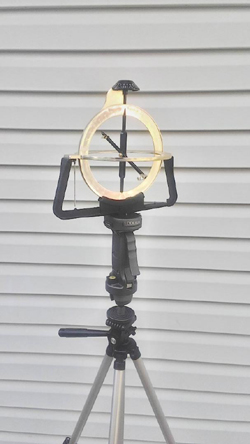 |
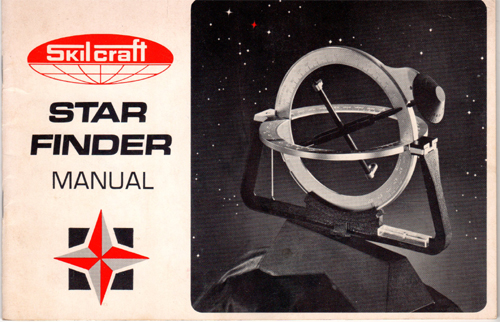 |
Marketed as a "star finder", the device could be adjusted to the observers latitude. A chart was included with right ascension and decliniation of major stars. By setting the declination and adjusting the clock wheel (on top) to local mean time, the pointer would indicate your star.
I adjusted the latitude setting to 90o (the north pole!) and found that the device could make a pretty good dioptra with 1o precision. Accuracy was another matter. The device had to be leveled using the little built in pendulum and aligned with true north. A little built in compass was included, but I found it to be difficult to use with the magnetic declination scale built into a loose clear plastic cover.
October 13, 2019
I made my first set of measurements at the rise of the full moon on 10/13/2019 from a location a few miles from my home (Buckley Overlook) where I had an unobstructed view of the eastern horizon. Subsequent measurments were taken at 30 minute intervals. I used the armillary to make just the azimuth readings. I used the hand held quadrant for altitude readings. After taking the measurements, I consulted Stellarium for predicted data.
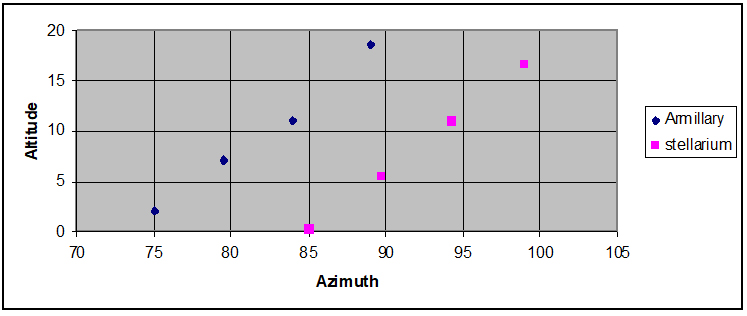
| Rising Full Moon Azimuth/Altitude - October 13, 2019 |
|||||
| Armillary Measurement | Stellarium Prediction | ||||
| All values in degrees | |||||
| Date | Time | Azimuth | Altitude | Azimuth | Altitude |
| 10/13/2019 | 18:48 MDT | 75 | 2 | 85.1 | 0.1 |
| 10/13/2019 | 19:18 MDT | 79.5 | 7 | 89.7 | 5.4 |
| 10/13/2019 | 19:48 MDT | 84 | 11 | 94.3 | 11 |
| 10/13/2019 | 20:18 MDT | 89 | 18.5 | 99 | 16.6 |
For the first set of data taken on October 13 2019, my altitude readings weren't too far off, but my azimuth readings were off by 10 degrees. I attribute this to improper north south alignment of the instrument. I did not trust the built in compass, so I used a more reliable compass corrected for magnetic declination. Obviously I didn't do this very well. Next full moon I plan on visiting my observation site at solar transit and establishing a true north line using the plumb bob shadow method. I can return at moonrise and use this line for more accurate alignment. On the plus side, the difference in azimuth was fairly consistent with the Stellarium data, almost exactly 10o. The two plots are nearly parallel.
November 12, 2019
I made the following observations on November 12, 2019 from Buckley Overlook using the armillary sphere.
| Date | Time MST | Measured Value | Stellarium Prediction | ||
| Azimutho | Altitudeo | Azimutho | Altitudeo | ||
| 11/12/2019 | 17:17 | 53 | 0 | 69.9 | 0.1 |
| 11/12/2019 | 17:47 | 57.5 | 5 | 74.4 | 5.1 |
| 11/12/2019 | 18:17 | 62 | 11 | 77.3 | 8.7 |
| 11/12/2019 | 18:47 | 67 | 18 | 83.1 | 16.1 |
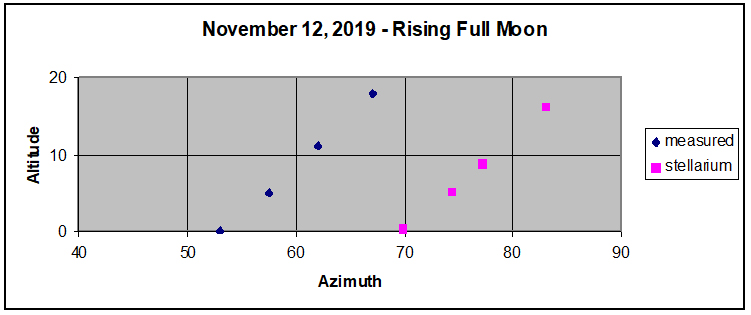
December 11, 2019
In the time since my last recorded observations, I completed the construction of the dioptra. This device has proven to be quite promising so far, making quite accurate calculations of the angle of separation between the Sun and Venus. On December 11, 2019 I used the dioptra to make measurements of the rising full moon.
The conditions at moonrise were very cloudy, and the moon was completely obscured at the predicted time of moonrise. The skies gradually cleared little, and I was able to make measurements starting an hour after moonrise. With this data I was able to extrapolate back to the Moon's position at moonrise.
| Date | Time MST | Measured Value | Stellarium Prediction | ||
| Azimutho | Altitudeo | Azimutho | Altitudeo | ||
| 12/11/2019 | 16:35 | - | - | 63.7 | 0.8 |
| 12/11/2019 | 17:35 | 72.5 | 11.2 | 72.4 | 10.8 |
| 12/11/2019 | 18:05 | 76.8 | 16.8 | 76.6 | 16.2 |
| 12/11/2019 | 18:35 | 80.7 | 22.3 | 80.8 | 21.7 |
| 12/11/2019 | 19:05 | 84.8 | 27.9 | 85.0 | 27.3 |
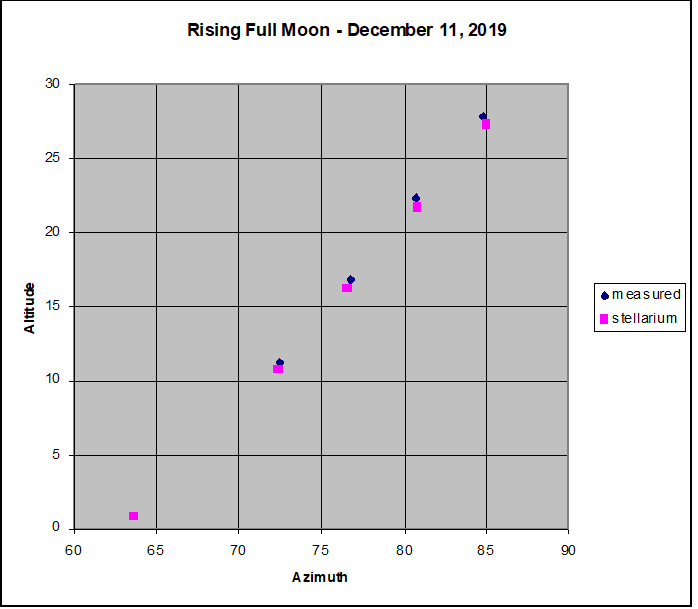
Subsequent Observations
Now that I have a pretty good agreement between expected and observed values, I will "officially" begin this activity. The following graph illustrates the path of the rising full Moon over three consecutive months, weather permitting. Data tables follow the graph.
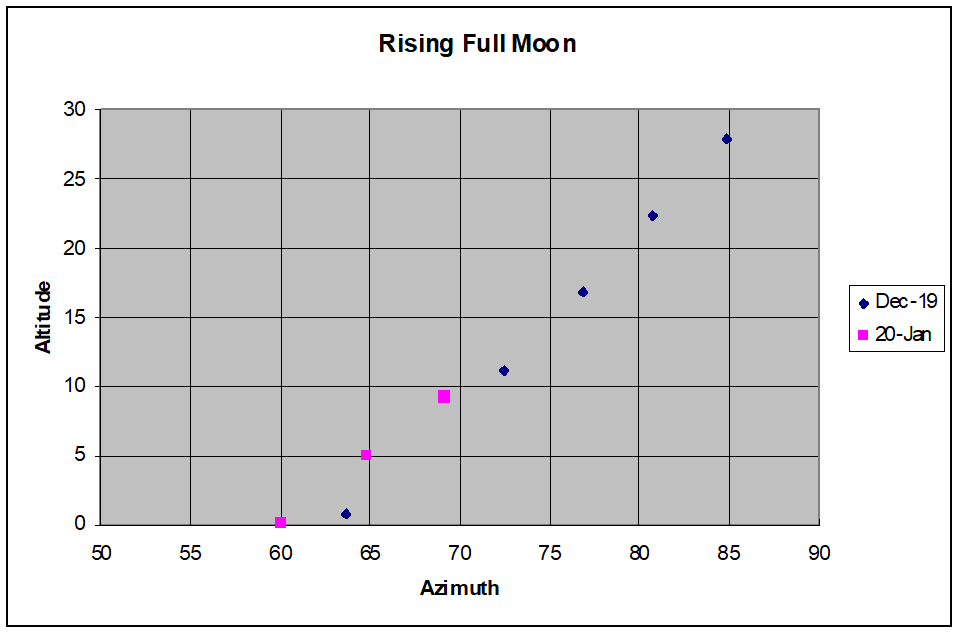
DATA
January 10 2020 - Altitude and azimuth of rising full Moon - Buckley Overlook - Minimum required observations, time cut short at end because of scheduling conflict, monthly meeting of Denver Astronomical Society at 19:30
| Time (MST) | Object | Azimuth | Altitude |
| 17:00 | Moon | 60.0 | 0.1 |
| 17:30 | Moon | 64.8 | 5.0 |
| 18:00 | Moon | 69.1 | 9.3 |
--Return to measuring select
objects--
--Return to Astronomy Before the Telescope index page--
--Binocrane.com home page--